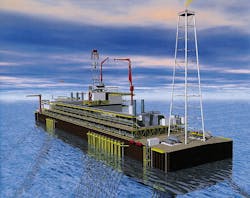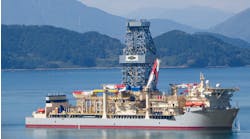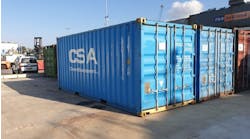French contractors at the forefront of West African, deepwater solutions
Jeremy Beckman
Editor
Europe
Bouygues Offshore's multi-function barge is one of several deepwater production/drilling concepts originating from France for the Gulf of Guinea.
- Paris-based Prosernat supplied this separation package for Enterprise's Pierce FPSO in the UK North Sea. ProserNat is working with other French contractors to combine its technology into deepwater subsea separation systems. [44,486 bytes]
- Field development layout for Kuito Phase 1a - Coflexip Stena Offshore is responsible for much of the subsea equipment/installation. [31,229 bytes]
- Offshore-related work is beginning to stream into the new Lobito yard in Angola, under construction by a joint venture involving Sonangol and ETPM. [26,386 bytes]
France's two major oil companies have reacted in different ways. Total became bigger, especially downstream, through a merger with PetroFina. Elf has resisted so far the idea of an alliance, but has sought to cut costs, partly through restructuring of its operations in Po Pau.
Elf has claimed it can afford to stay independent. Although its net income has decreased, it has not suffered as much as other oil majors such as Shell. Total is in a similar situation, according to Philippe de Panafieu of French petroleum research body CEPM. "Both claim to be getting good returns, even at $10/bbl. But French contractors and service companies are suffering more, because the E&P budgets of these and other oil companies worldwide have decreased substantially.
"Upstream specialists in geophysics, like CGG, and drilling services (Geoservices), will be more affected by these cuts - CGG, for instance, cancelled an option for a second newbuild 3D seimic vessel from Chantiers de l'Atlantique. But others engaged more in deep offshore engineering have good order books, such as Bouygues Offshore, Doris Engineering, and ETPM."
A high percentage of those orders relate to the Elf-operated Girassol development in Angolan Block 17. Vachier feels that the contractors are still too reliant on Elf and Total, and ought to expand their activities more with other companies, they have the capabilities for it. On the other hand, these two are at present among the more lucrative patrons.
While others are cutting back on new field work, Elf has started up production this year from the $250 million Maharaja-Lela gas-condensate project offshore Brunei. With Agip, Elf has signed a contract to re-develop the Dorood oilfield, lying mainly offshore Kharg Island in the Persian Gulf, in order to boost recovery from the field to 1.5 billion bbl. Investment costs here will be just under $1 billion.
In Nigeria, it is part of a consortium that is increasing throughput at the Bonny Island LNG terminal from 7.4 to 11 bcm annually. And in deepwater Mississippi Canyon 305 block in the Gulf of Mexico, where Elf is operator, it has just announced a major discovery on the Aconcagua prospect in 2,155 meters of water.
Total also reported recently a significant find in Mississippi Canyon block 942, where it is a joint shareholder with operator Shell. The well, drilled to 5,500 m T/D in waters 1,200 m deep, encountered two oil-bearing horizons with total thickness of 60 m.
The merger with PetroFina brings Total further acreage in the Gulf of Mexico, as well as strong development prospects in the UK North Sea and offshore Vietnam. Also offshore Iran, Total operates stage two and three of the South Pars gasfield development, which involves commissioning of two new platforms. Field production, anticipated in summer 2001, could yield up to 2 bcf/d of gas plus associated condensate.
With other European and Asian oil companies negotiating Iranian buy-back contracts, GEP is responding by planning a technical mission to Iran to introduce French contractors/service groups to NIOC representatives.
The fact that American companies are barred from competing in Iran and Iraq clearly benefits the French, Vachier says. On the other hand, French contractors have made little progress themselves in the Gulf of Mexico, despite a fanfare over numerous ventures with companies in Houston. North America constitutes no more than 5% of French oil industry turnover, Vachier claims.
There are exceptions. Doris is still active in the PetroCanada-led Terra Nova development offshore Newfoundland. Off California, Coflexip Stena Offshore installed Exxon's Harmony Heritage pipeline last fall, the first application for the CSO modular J-Lay spread. CSO Constructor was deployed for the work in 300 m of water (although the technique is designed for use in up to 1,500 m of water). The 12-in. line was initiated by a J-tube pull and terminated with a steel catenary riser.
Although North Sea work has tailed off (for everyone, not just the French), CSO continues to pick up subsea assignments. Recently it devised a new riser configuration for a shallow water installation on Kerr-McGee's Janice Field, where two mid-water arches were specified to support risers and umbilicals connecting the subsea installation to the Janice `A' platform.
The water depth, 79 m, was below the 90 m minimum normal for such arches. In shallow waters, there is a risk of flowline/riser clash, plus swell impact, but arches had to be installed on Janice for cost purposes. CSO's solution involved use of a riser bend limiter and hold-back clamp tethered to a gravity base which maintains the riser and umbilical configuration, at the same time securing it against wave actions from a 100-year storm.
Elsewhere, ETPM has become more active offshore Brazil, following the dissolution of its alliance with McDermott. For instance, it is bidding the EPCI contract for the umbilical riser flowline for Petrobras' Barracuda Phase 1 development. This is based on an FPSO plus a Spar or TLP linked to subsea wellheads, in waters 800 m deep. Up to 60 risers and flowines, 30 producer wells and 15 water injectors are planned. Production is due to start in 2001, at 200,000 b/d.
CGG is reportedly performing Brazil's first aeromagnetic surveys, over the Santos and Espiritu Santo basins, covering blocks to be issued for tender in the country's first open concession bidding round this June. CSO remains strong in Brazil, although its manufacturing venture Brasflex anticipates a temporary dip in flexible pipe sales.
In the Black Sea, Bouygues Offshore and Bouygues have just been awarded a $360 million contract by the Caspian Pipeline Consortium to build a new marine terminal near Novorossisk to handle oil piped overland from the Caspian.
Investments
But West Africa remains the most prospective source of offshore income. "French contractors are very much focused on West African markets," says de Panafieu, "trying to make breakthroughs on problems such as J-Lay for deepwater pipelines. CSO's Kitty, ETPM's DLB Polaris and Saibos' FDS are all examples of new or converted vessels in DP mode designed for this task, deploying laser-based, quadruple joint welding to accelerate the pace of laying. All this, however, still has to be qualified or accepted."The renegotiations over the Girassol FPSO topsides construction affects the French contractors concerned in commercial terms - particularly the appointed yard in Fos, southern France which looks like losing the work to a lower-cost facility in the Far East. But this scenario is inevitable in a low price oil environment, says de Panafieu, emphasising that the South Pars platform contracts also went elsewhere (to a yard in Abu Dhabi). Welders outside Europe cost up to five times less, he points out.
A bigger achievement than profitability on Girassol may be the successful installation of the 1.3 km long riser towers. This is the responsibility of the Alto Mar Girassol team, including ETPM for fabrication and Doris for engineering. "There will be 140 bundles to tow 250 km from the beach at Soyo, Angola to the field," de Panafieu says, "in the form of carrier pipes. And 277 connections will be needed, all by ROV. To do that at 1,350 m water depth is a big challenge."
Tank tests in Toulon, and up ending trials in a deep lake in the south of France (involving specially developed instrumentation) produced quantitative data approximating to what had been calculated, according to Doris' Michel Deguen. A bottom tow trial of 200 m long bundle over 500 km in Angola was successful also, says de Panafieu, "in that they didn't lose the bundle, and positioned it well.
"But to install an actual riser tower, 1,300 m long, of composite assembly, housing four production bundles, plus service lines - all assembled in a syntactic foam for buoyancy and insulation; and then when it's on site, upend it from the horizontal to the vertical, the foam must not break loose and flow to the surface - all this is complicated. The incentive for this to succeed is enormous - the prototype must not fail.
"Another problem is that Girassol's oil is viscous, paraffinic and not very hot. The temperature between the wellhead and FPSO must be strictly maintained - no more than one degree C per km may be lost. And a further challenge is to inject gas at the foot of the riser to lift the column. However, they must be careful as flow must be continuous without too many slugs forming.
"Institut Francais du Petrole is engaged in software simulation in this regard for polyphasic flow calculations. Also in Solaize near Lyon, IFP's experimental loop is reproducing characteristics of Girassol's oil gas and water to watch for the danger of hydrate or paraffin deposits."
Vachier adds that the mooring system for Girassol, which includes use of suction anchors and polyester ropes to anchor the associated loading buoy, is another technical breakthrough.
Nigeria
Beyond Girassol, French contractors are monitoring another deepwater Elf-operated project off Angola and also Elf's shallow water Amenam project offshore Nigeria. Tenders may have been issued for a fixed platform and storage vessel, producing up to 150,000 b/d. TPG, Bouygues Offshore, Doris, and ETPM are thought to be bidding, with ETPM's package including use of its Smart Leg installation technique.Also off Nigeria, ETPM is in the frame for Shell's shallow water Ea project, bidding an EPCI contract for four wellhead platforms which would be built at its Warri yard.
Another new Elf project is Tchibeli offshore Congo. Here ETPM has the contract to lay an electric cable and water injection line, plus a 25 km insulated production line between the Tchibeli Field and its host platform, the Nkossa barge. DLB Polaris will employ S-Lay for the installation. The production line features pipe-in-pipe technology for the insulation, created by Interpipe. The latter, based in Louveciennes, Paris, also developed a pipe-in-pipe system for Shell Expro's HT/HP ETAP project in the UK North Sea.
CSO is part of the consortium working on the Chevron-led Kuito Phase 1a facilities, another deepwater Angolan development. CSO is supplying flexible flowlines and risers and umbilicals, plus two gas lift distribution manifolds and one subsea control distribution manifold.
France's CEPM is also evaluating numerous other research projects for 3,000 m water depths. One is for a new drilling riser, such as Sedco Forex or Pride/Foramer. Cameron in Beziers is working on a BOP for drilling in these depths.
The problem with drilling at these greater depths, says de Panafieu, "is that the transmission time between the surface and sea bottom is too long if you use a hydraulic pulse. While waiting 2-3 minutes for that, you can have a blow-out. So you must use an alternative technique that works faster, such as acoustic links. You must also diminish the weight of the riser - perhaps develop a concentric riser to cut mud volumes."
Other new R&D projects being undertaken by French contractors include:
- a deepwater wellhead and drilling tension raft platform
- synthetic ropes for West African mooring systems
- launching and uprighting of long skirt piles from a barge
- deepwater pipeline tee installations
- H2S migration through polymer coating in flexible pipes (IFP and CSO).
Copyright 1999 Oil & Gas Journal. All Rights Reserved.




